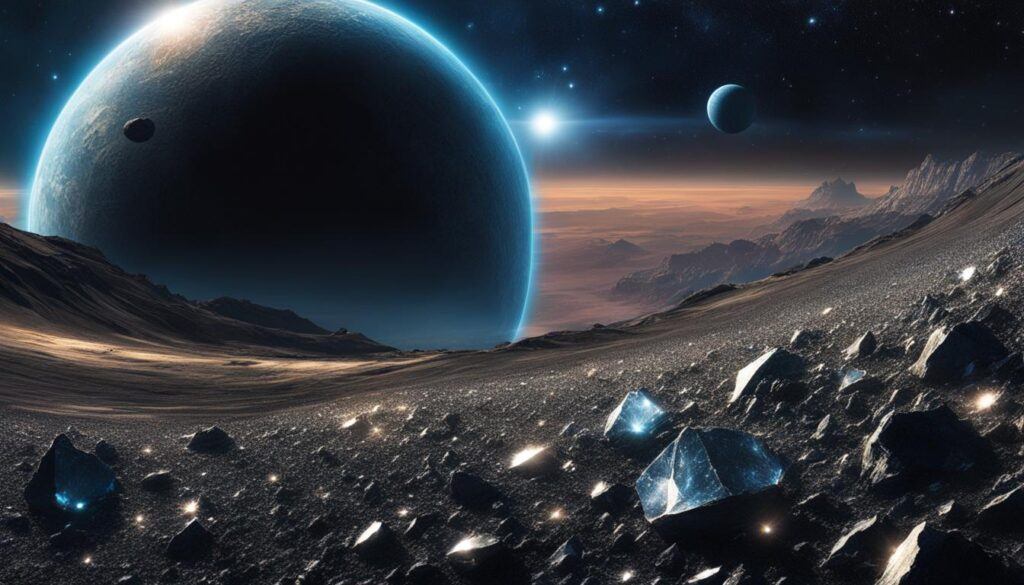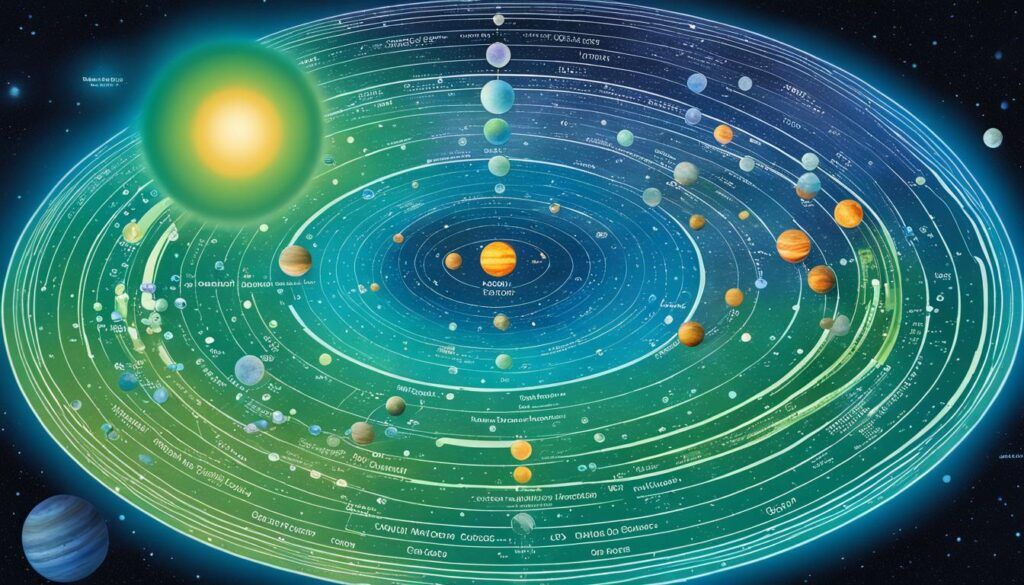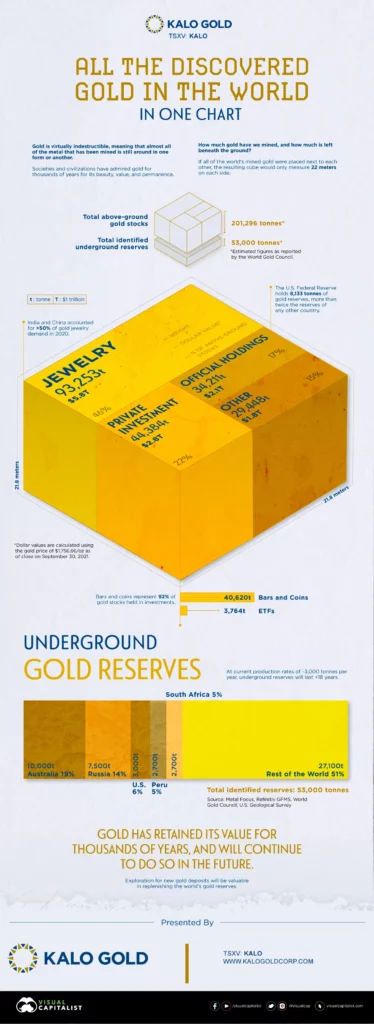Look:
Despite the rarity of precious metals on Earth, there are places in the universe where these elements are more abundant.
So, which planet is the richest in gold?
One of the discoveries the astronomers made is a planet primarily made of carbon, with a large portion likely composed of diamond.
Another intriguing discovery is Titan, the largest moon of Saturn, which has lakes filled with liquid methane.
On top of that, certain asteroids are estimated to contain trillions of dollars worth of gold and other valuable metals beneath their surfaces.
While the exact compositions of these heavenly bodies are still not fully understood, the potential for gold abundance in planets beyond Earth is fascinating.
Let’s explore some of the most significant discoveries and estimates in our quest for the richest planet in gold.
Key Takeaways:
- There are planets primarily made of carbon, with a large portion likely composed of diamond.
- Titan, the largest moon of Saturn, has lakes filled with liquid methane.
- Some asteroids could have trillions of dollars worth of gold and other valuable metals beneath their surfaces.
Without further ado, let’s get started.
Investing in the U.S.? Our #1 Recommended Gold IRA Company
The Diamond Planet
As it was already mentioned earlier, the astronomers have made a fascinating discovery – a planet primarily composed of carbon, making it incredibly dense.
This diamond-rich planet is believed to contain a significant amount of this precious gemstone. While the planet is slightly larger than Jupiter, it is more than 20 times denser.
Scientists speculate that this unique planet is a remnant of a once massive star. Over time, the star lost its outer layers to a pulsar, resulting in the formation of this dense carbon planet.
This extraordinary celestial body is located approximately 4,000 light-years away from Earth, rendering it currently inaccessible.

To further understand the composition and characteristics of this diamond-rich planet, scientists rely on advanced telescopes and observations.
While it remains a distant spectacle for now, this discovery offers valuable insights into the diverse nature of celestial bodies in our vast universe.
The Density of the Diamond Planet
| Planet | Mass | Density (g/cm³) |
|---|---|---|
| The Diamond Planet | Slightly larger than Jupiter | More than 20 times denser than Jupiter |
| Jupiter | 1.898 × 10^27 kg | 1.326 g/cm³ |
The dense nature of the diamond planet is astounding.
While its size is comparable to Jupiter, its extraordinary density sets it apart. Scientists are keen to learn more about its composition and the processes that led to the formation of such a unique and valuable celestial object.
Titan’s Seas of Natural Gas
Titan, the largest moon of Saturn, boasts a unique distinction in the solar system.
It is renowned for its dense atmosphere and the presence of stable bodies of liquid on its surface.
While lakes on Earth are composed of water, Titan’s lakes hold a different secret – they contain lakes of natural gas, specifically liquid methane.
The Cassini space probe, which orbited Saturn and its moons between 2004 and 2017, made groundbreaking discoveries about Titan’s surface.
One of the most fascinating findings was the presence of lakes filled with liquid methane. These lakes play a crucial role in the moon’s diverse and dynamic environment.
What sets Titan’s lakes apart is their incredible size. The larger lakes on Titan contain an estimated 130 billion tons of natural gas, surpassing the total proven reserves of Earth by over 31 times.
This abundance highlights the vast reserves of natural gas that lie within this enigmatic moon.
Titan’s Unique Composition
Titan’s dense atmosphere and stable bodies of liquid can be attributed to its frigid temperatures.
The moon’s surface is incredibly cold, with temperatures plummeting to approximately minus 290 degrees Fahrenheit (minus 179 degrees Celsius).
These extreme conditions allow methane to exist in a liquid state, forming lakes that cover vast areas of Titan’s surface.
The presence of organic compounds, such as methane, on Titan has captivated scientists and fueled exploration excitement.
Many hypothesize that these compounds, along with a combination of other complex molecules, could potentially provide insights into the origin of life.
Unlocking Titan’s Mysteries
Let’s face it:
Titan and its lakes of natural gas is pretty fascinating.
The data collected by the Cassini mission has provided valuable insights into this unique moon and its potential for harboring extraterrestrial life.
Future missions, such as NASA’s Dragonfly mission set to launch in 2026, aim to take exploration to the next level. Dragonfly will deploy a drone-like rotorcraft to navigate Titan’s diverse terrain, collecting data and investigating the moon’s geology, atmosphere, and the intriguing composition of its lakes.

The image above offers a breathtaking view of Titan, showcasing its awe-inspiring beauty and the ethereal nature of its lakes of natural gas.
As scientists delve deeper into the mysteries of this intriguing moon, there is no doubt that Titan will continue to captivate our imagination and provide valuable insights into the wonders of the universe.
$20 Trillion Gold Asteroid
In a book titled “Mining The Sky: Untold Riches of the Asteroids, Comets and Planets,” author John S. Lewis highlights the potential of asteroids for accessing valuable resources.
One asteroid mentioned is 3554 Amun, which is a metallic asteroid speculated to have trillions of dollars worth of gold, iron, nickel, cobalt, and platinum beneath its surface.
While these estimates cannot be verified without surface probes, it is worth considering that gold on Earth’s surface primarily came from asteroids.
The heavy metals sank to Earth’s core during its formation, and only after the surface cooled did metals remain near the surface, making asteroids a likely source of these valuable metals.

In a fascinating overview of potential wealth in space, author John S. Lewis delves into the exciting prospects of asteroids containing valuable metals.
Asteroid Mining Possibilities
Exploring and exploiting metallic asteroids has the potential to revolutionize resource extraction.
These asteroids are remnants of the early solar system and, as such, contain concentrations of valuable metals that far surpass what is found on Earth’s surface.
With the increasing demand for precious metals and the limited availability of these resources, the prospect of mining asteroids becomes even more enticing.
“The potential wealth locked within metallic asteroids is staggering. They hold vast amounts of gold, iron, nickel, cobalt, and platinum that could significantly impact our economy and resource sustainability.”
– John S. Lewis, Mining The Sky: Untold Riches of the Asteroids, Comets and Planets
It is important to note that the extraction of these valuable metals from metallic asteroids is still a subject of research and development.
The logistics, technological challenges, and ethical considerations involved in such endeavors are vast. However, the potential for accessing trillions of dollars worth of gold and other valuable metals cannot be ignored.
Asteroids as a Source of Precious Metals
The concept of gold and valuable metals originating from asteroids is not mere speculation.
In fact, gold found on Earth‘s surface is thought to have come from ancient asteroid impacts. During the formation of the planet, heavy metals such as gold sank deep into the Earth’s core.
Only after the surface cooled did these metals resurface, resulting in the presence of gold and other valuable metals we mine today.
Given this understanding, it is reasonable to assume that asteroids, being remnants of early planetary formation, could hold significant wealth in the form of precious metals.
Metallic asteroids, in particular, have captured the attention of scientists and researchers due to their high concentrations of gold and other valuable metals.
While surface probes are needed to verify the precise composition and wealth potential of asteroids like 3554 Amun, imagining the prospects of accessing trillions of dollars worth of gold and other valuable metals is incredible.
Interstellar Alcohol Cloud
Astronomers at the Jodrell Bank Observatory have made a fascinating discovery in our galaxy.
They have detected a massive cloud of methyl alcohol, also known as wood alcohol, stretching over billions of miles.
This extraordinary cloud is believed to rotate around a central star in a stellar nursery, shedding new light on the processes involved in star formation.
However, it is important to note that while this cloud of alcohol is intriguing, methyl alcohol is toxic to humans and primarily used for industrial purposes.
The discovery of this massive cloud contributes to our understanding of the universe but does not offer any potential wealth or opportunities for exploitation.
Understanding Star Formation
“The discovery of this massive cloud of methyl alcohol provides valuable insights into the intricate mechanisms involved in star formation. By studying the composition and behavior of such interstellar clouds, astronomers can unravel the complex processes that give birth to stars and planetary systems.”
Stellar nurseries are regions within galaxies where new stars are formed.
They consist of vast clouds of interstellar gas and dust, which eventually collapse under gravity, leading to the formation of protostars.
This discovery adds to our knowledge of the diverse and dynamic environments within these nurseries and the crucial role that alcohol molecules play in the celestial ecosystem.
The Significance of Methyl Alcohol
Wood alcohol, or methyl alcohol, is a simple organic compound consisting of one carbon atom, three hydrogen atoms, and one oxygen atom.
Its presence in interstellar space indicates the existence of complex chemical processes and the potential for the formation of more complex organic molecules.
While methyl alcohol may not have direct practical implications for us on Earth, studying its distribution and behavior provides valuable insights into the broader chemistry of the universe and the processes that shape celestial bodies.
Water in Space
While water is abundant on Earth, there are other places in our solar system that are thought to potentially contain vast reserves of water.
One prime candidate is Europa, an icy moon of Jupiter, which is believed to have an extensive liquid ocean beneath its surface.
The tidal flexing caused by its orbit around Jupiter generates heat, potentially creating underground oceans. Ceres, the largest object in the asteroid belt, is another candidate for water reserves.
A 2005 study observed the characteristics of Ceres and suggested the presence of water ice.

| Location | Description |
|---|---|
| Europa | Icy moon of Jupiter with a liquid ocean beneath its surface |
| Ceres | Largest object in the asteroid belt with potential water ice |
Gold Reserves on Earth
The world’s largest gold reserves are held by the United States, with a stockpile totaling over 8,100 tons.
This amount far surpasses the combined holdings of the next three largest gold-holding countries: Germany, Italy, and France.
Even Russia, with its significant gold reserves, ranks as the fifth-largest holder in the world.
Gold Reserves Comparison
| Rank | Country | Tons of Gold |
|---|---|---|
| 1 | United States | 8,100 |
| 2 | Germany | 3,362 |
| 3 | Italy | 2,451 |
| 4 | France | 2,436 |
| 5 | Russia | 2,299 |
Governments hold these gold reserves as a hedge against hyperinflation or economic crises. The stability and perceived value of gold make it a reliable safeguard for preserving wealth.
Gold reserves contribute to the global economy and serve as an anchor for their respective countries. The stored gold not only acts as a store of wealth but also bolsters confidence in a nation’s financial stability.
As the largest holder of gold reserves, the United States maintains a position of economic strength that supports its currency and solidifies its role as a global economic leader.
How Gold Reserves Work
Gold has been a trusted means of exchange for thousands of years, playing a vital role in the global economy.
While it is no longer directly tied to the value of paper currency, gold continues to hold significant importance.
Governments and central banks around the world maintain substantial bullion reserves as a store of wealth and a hedge against inflation and economic turmoil.
Gold reserves, measured in metric tons, serve as a strategic asset for countries, providing stability and security.

These reserves are often kept securely in vaults, ensuring their availability during times of crisis or when there is a need to stabilize the financial system.
“Gold is the world’s premier store of value. It stands as an insurance policy against currency fluctuations and preserves wealth for future generations.”
Besides governments, businesses also recognize the value of gold.
Many industries rely on gold as a commodity asset, using it in the production of electronics, medicine, jewelry, and more. Its unique properties and scarcity make it an essential component in various applications.
For investors, gold provides a reliable means of preserving wealth and hedging against inflation.
During times of economic uncertainty or when there are concerns about the stability of fiat currencies, gold tends to perform well, maintaining its value or even increasing in price.
Speaking of which:
You might want to grab this FREE guide to learn more about investing in a Gold IRA.
Overall, gold reserves play a crucial role in maintaining economic stability and protecting wealth.
Whether in the form of bullion or as an investment asset, gold’s historical significance and intrinsic value make it an invaluable part of the global financial landscape.
The Benefits of Gold Reserves:
- Store of Wealth: Gold retains its value over time, protecting wealth from economic downturns and currency fluctuations.
- Hedging Against Inflation: As central banks print more money and inflation rises, gold acts as a hedge, preserving purchasing power.
- Global Acceptance: Gold is recognized and accepted worldwide, making it a highly liquid asset that can be easily converted into cash.
- Diversification: Including gold in investment portfolios helps diversify risk and reduce dependence on other assets.
Gold on Other Planets
When considering the abundance of gold in space, it is crucial to understand that real wealth stems from our ability to create products and services that fulfill human desires.
While the idea of a colossal golden asteroid may be captivating, its practical applications would be limited, contributing only marginally to real wealth.
Instead, our focus should be on leveraging resources ingeniously to develop innovative offerings that address the needs and wants of society.
Gold holds value not solely due to its scarcity, but primarily because of its utility and the public perception of its worth.
While it is true that gold has been regarded as a store of wealth for millennia, its true significance lies in its usage as a commodity asset in various industries.
Furthermore, gold serves as a hedge against inflation and economic downturns, making it an attractive investment option for many.
To create genuine wealth, we must concentrate efforts on utilizing our resources inventively and creatively.
By doing so, we can craft products and services that truly resonate with people, making their lives better and meeting their ever-changing desires.
It is through innovation and resourcefulness that we generate value that lasts, shaping a prosperous future for ourselves and the world at large.
FAQ
Which planet is the richest in gold?
There is currently no planet known to be the richest in gold. However, there are potential sources of gold in celestial bodies such as asteroids and metallic planets.
What is the diamond planet?
The diamond planet is a planet primarily composed of carbon and is believed to have a large portion made of diamond. It is a dense planet, slightly more massive than Jupiter but more than 20 times as dense.
What are Titan’s seas made of?
The seas on Titan, the largest moon of Saturn, are not made of water like on Earth. They are believed to contain liquid methane, also known as natural gas, with estimates suggesting vast reserves.
Is there gold on asteroids?
Some asteroids are speculated to have trillions of dollars worth of gold and other valuable metals beneath their surfaces. While these estimates cannot be verified without surface probes, asteroids are considered potential sources of these valuable metals.
What is the interstellar alcohol cloud?
The interstellar alcohol cloud is a massive cloud of methyl alcohol discovered in our galaxy. It is believed to rotate around a central star in a stellar nursery, providing insights into star formation rather than potential wealth.
Where can we find water reserves in the Solar System?
Europa, an icy moon of Jupiter, is believed to have an extensive liquid ocean beneath its surface. Ceres, the largest object in the asteroid belt, is another candidate for water reserves based on observations suggesting the presence of water ice.
Which country holds the largest gold reserves?
The United States holds the largest stockpile of gold reserves in the world, with over 8,100 tons. Germany, Italy, and France also hold significant amounts of gold. Russia ranks fifth in terms of gold reserves.
How do gold reserves work?
Gold reserves serve as a safeguard against hyperinflation or economic crises for governments.
The yellow precious metal is measured in metric tons and is considered a store of wealth.
It is also used as a commodity asset in various industries and acts as a hedge against inflation or economic downturns for investors.
Does gold equal real wealth?
While exploring the abundance of gold in space may seem enticing, real wealth comes from the ability to create products and services that satisfy human desires.
Gold’s value is not solely dependent on its scarcity but rather its usefulness and the perception of its value.
Check out our in-depth guide, if you’d like to learn more about the best gold investments this year.
Now, we’d like to hear from YOU:
- Which planet is the richest in gold, in your opinion?
- What new info did you find for yourself here?
Let us know in the comments below!




